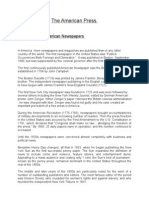01 c1 Set 1 Que 1204-511 Paragraph Headings PDF
01 c1 Set 1 Que 1204-511 Paragraph Headings PDF
Uploaded by
Tanító TanulóCopyright:
Available Formats
01 c1 Set 1 Que 1204-511 Paragraph Headings PDF
01 c1 Set 1 Que 1204-511 Paragraph Headings PDF
Uploaded by
Tanító TanulóOriginal Title
Copyright
Available Formats
Share this document
Did you find this document useful?
Is this content inappropriate?
Copyright:
Available Formats
01 c1 Set 1 Que 1204-511 Paragraph Headings PDF
01 c1 Set 1 Que 1204-511 Paragraph Headings PDF
Uploaded by
Tanító TanulóCopyright:
Available Formats
Euro C1 Reading Page 1
Task One: Paragraph Headings (10 minutes) Question 1-6
Read the following article about tabloid journalism.
Choose the paragraph heading that best matches each paragraph from the choices
A I and tick the appropriate letter on the separate answer sheet.
There are two paragraph headings that you do NOT need.
The first one has been done for you.
Paragraph headings
A A winning layout
B What makes it different?
C Thrilled by calamity - Example
D The power of subculture
E Why so cheap?
F Teaching lessons in ethics
G The camera cannot lie
H Compact and shocking
I Snapshots trigger new boom
Euro C1 Reading Page 2
Example C
Tabloid journalism has been in existence for several centuries now. "People have long been fascinated
by death, adversity and tragedy, and one could argue that turning these tragedies into entertainment is...
natural... Sensational appeals, by engaging the emotions of the audience, serve as a powerful rhetoric of
persuasion for moral and political arguments.
1
The word "tabloid" itself has several definitions. In 1884 it was trademarked as a name for compressed
drugs. Beginning in 1901, "tabloid" was used to identify a special type of newspaper - one that was
condensed, usually half the size of a normal newspaper. These papers were commonly identified with
boisterous, brief news content, some fiction, and often they blatantly appealed to the human interest in
crime, sex, and disaster.
2
But tabloid journalism found its roots prior to the 20th Century in sensationalism of the time, laying the
foundation for the tabloid market of today. One of the first mass circulation objects of sensationalism
was Foxe's Book of Martyrs, (1570) which shows, quite explicitly, the consequences of the moral codes of
the religious authorities. It tells the dramatic story of some of the most thrilling periods in Christian
history.
3
Tabloids, as we know them today, were known as "penny papers" in the 1830's and 1840's. The New
York Sun, founded in 1833 by Benjamin Day, was the first successful "penny paper" in America. The
Sun's sensational news formula first appeared in lap-sized tabloid format and gained a daily circulation
of 20,000 within two years of life, possibly larger than any other daily in the world up to that time. Over
the next two decades many metropolitan printers tried to launch penny papers but only a handful had
success.
4
It was with the establishment of New Yorks Illustrated Daily News on June 26, 1919 by Joseph Medill
Patterson, that tabloid journalism started growing again at an incredible pace. Americas first picture
tabloid brought photos on events such as explosions, hunger strikes and executions. During the years
between 1920 and 1945, at a time when history shaped sensationalistic newspapers, it contributed to
history through photographs and stances on political issues.
5
In fact, the use of pictures was one of the primary reasons Joseph Patterson gave for printing the
Illustrated Daily News in the morning, for in a letter he stated, all morning New York papers are alike
and none of them print pictures. Contrary to other papers, the Daily News could even be appealing to
the flood of immigrants in New York that had yet to perfect their English. It was written on a level that
was easy to understand and relate to.
6
Over the years, tabloid journalism has become an important facet of our everyday life. From
reporting on the events and news in a non-biased manner, to shaping significant events of time
through its sensationalistic flare, tabloid journalism can be argued to be as important to history as
the historical events on which it report. One can see how the use of sensationalism has affected
the depiction of history, and one should be aware of the power that media possesses to shape the
pages of history whether correct or not.
You might also like
- Asa Briggs and Peter Burke, A Social History of MediaDocument8 pagesAsa Briggs and Peter Burke, A Social History of MediaValéria Garcia0% (1)
- News from Germany: The Competition to Control World Communications, 1900–1945From EverandNews from Germany: The Competition to Control World Communications, 1900–1945Rating: 4.5 out of 5 stars4.5/5 (2)
- June 13, 1971Document5 pagesJune 13, 1971Collier MeyersonNo ratings yet
- Chapter 31Document26 pagesChapter 3112345676543No ratings yet
- Mass Media Lecture Notes Sem-1Document42 pagesMass Media Lecture Notes Sem-1Adina Minca100% (2)
- 01 c1 Set 1 Que 1204-511 Paragraph Headings PDFDocument2 pages01 c1 Set 1 Que 1204-511 Paragraph Headings PDFTanító TanulóNo ratings yet
- Reading&Writing A C1 Task One QueDocument2 pagesReading&Writing A C1 Task One QuejayappriyaNo ratings yet
- EURO C1 ReadingDocument12 pagesEURO C1 ReadingToth Manka100% (1)
- Journalism Changes The WorldDocument19 pagesJournalism Changes The Worldpaulstefan2002No ratings yet
- Module 2 History of The Media IndustryDocument19 pagesModule 2 History of The Media Industryapi-521757644No ratings yet
- Evolution of The Press - Apre - OralDocument3 pagesEvolution of The Press - Apre - OralFilipa Fernandes 2017101No ratings yet
- Topic Two - History & DevtDocument8 pagesTopic Two - History & DevtAmirul AdliNo ratings yet
- An Overview of NewspaperDocument7 pagesAn Overview of NewspaperopesadedanNo ratings yet
- Passionist Sisters' School Upper Cahilsot Calumpang General Santos CityDocument6 pagesPassionist Sisters' School Upper Cahilsot Calumpang General Santos Cityfranz anthonyNo ratings yet
- The American PressDocument5 pagesThe American Presskalasanty100% (1)
- Mencher. Writing The Story.Document22 pagesMencher. Writing The Story.MiNo ratings yet
- (The Making of The Twentieth Century) A. J. Nicholls (Auth.) - Weimar and The Rise of Hitler (1968, Macmillan Education UK)Document223 pages(The Making of The Twentieth Century) A. J. Nicholls (Auth.) - Weimar and The Rise of Hitler (1968, Macmillan Education UK)The Rabbithole WikiNo ratings yet
- A History of Newspapers (Enregistré Automatiquement)Document24 pagesA History of Newspapers (Enregistré Automatiquement)95m7f6btnrNo ratings yet
- Samuel Bertschman - Think - Journalism's - A - Tough - Field - Today - Try - Being - A - Reporter - in - The - Gilded - Age-StudentDocument8 pagesSamuel Bertschman - Think - Journalism's - A - Tough - Field - Today - Try - Being - A - Reporter - in - The - Gilded - Age-StudentbertschmansamuelNo ratings yet
- Chapter One: Guardian, New Nigerian, Nigerian Tribune, Tell, Newswatch, The News, Etc, All PublishDocument4 pagesChapter One: Guardian, New Nigerian, Nigerian Tribune, Tell, Newswatch, The News, Etc, All PublishIjasini Banga GabrielNo ratings yet
- bmc-114-96-108 POLITICS AND MEDIADocument13 pagesbmc-114-96-108 POLITICS AND MEDIAV.j. SinghNo ratings yet
- YearZero John PilgerDocument80 pagesYearZero John Pilgerbosman100% (4)
- Revolutions in Communication: Media History From To The Digital AgeDocument52 pagesRevolutions in Communication: Media History From To The Digital AgeErsin TukenmezNo ratings yet
- A Study On Customer Satisfication - The New Indian Express-VizagDocument86 pagesA Study On Customer Satisfication - The New Indian Express-Vizagmadhukar n60% (5)
- History and Principles of JournalismDocument21 pagesHistory and Principles of JournalismDwi Sloria SuhartiNo ratings yet
- The 51 Best Magazines EverDocument19 pagesThe 51 Best Magazines Evermascomweb100% (1)
- A Novel Marketplace: Mass Culture, the Book Trade, and Postwar American FictionFrom EverandA Novel Marketplace: Mass Culture, the Book Trade, and Postwar American FictionRating: 5 out of 5 stars5/5 (1)
- The Involved Eye: Robert Capa As Photojournalist 1936-54 Lawrence RudnerDocument10 pagesThe Involved Eye: Robert Capa As Photojournalist 1936-54 Lawrence RudnerMarius StanNo ratings yet
- Newspapers - A HistoryDocument32 pagesNewspapers - A HistoryIkirezi EuniceNo ratings yet
- The Journalist's Handbook: An Insider's Guide To Being a Great JournalistFrom EverandThe Journalist's Handbook: An Insider's Guide To Being a Great JournalistRating: 1 out of 5 stars1/5 (1)
- History of Tabloid Newspapers in EnglandDocument32 pagesHistory of Tabloid Newspapers in EnglandRichardRooney100% (2)
- Yellow Journalism Thesis StatementDocument6 pagesYellow Journalism Thesis Statementdnnpkqzw100% (2)
- Dexter Jimenez ReportDocument13 pagesDexter Jimenez ReportMei JimenezNo ratings yet
- Comic Art in The Philippines (John A. Lent) (1998)Document14 pagesComic Art in The Philippines (John A. Lent) (1998)Conjo BalagnasNo ratings yet
- Sierra Price: TH STDocument12 pagesSierra Price: TH STapi-316471453No ratings yet
- Chalaby 1996 Journalism As An Anglo American Invention A Comparison of The Development of French and Anglo AmericanDocument24 pagesChalaby 1996 Journalism As An Anglo American Invention A Comparison of The Development of French and Anglo AmericansmyrnaiosNo ratings yet
- Module 1 Summer 15Document14 pagesModule 1 Summer 15Hazman DanialNo ratings yet
- HHB ch3Document45 pagesHHB ch3susanwhittenNo ratings yet
- Introduction To Print MediaDocument14 pagesIntroduction To Print MediaUmamah EzeNo ratings yet
- The 1930s Were Humanity's Darkest, Bloodiest Hour. Are You Paying Attention Jonathan Freedland The GuardianDocument1 pageThe 1930s Were Humanity's Darkest, Bloodiest Hour. Are You Paying Attention Jonathan Freedland The GuardianSOFIA SAVOLDONo ratings yet
- Int JocoDocument81 pagesInt JocoNegesseNo ratings yet
- Etica in Presa Si Citate Din Tea Mass MediaDocument454 pagesEtica in Presa Si Citate Din Tea Mass MediacristishNo ratings yet
- Photo Journalists: Capturing The Unseen.Document9 pagesPhoto Journalists: Capturing The Unseen.inboxdavid1No ratings yet
- Homework: 1) The Great DepressionDocument7 pagesHomework: 1) The Great DepressionDiana MarcusNo ratings yet
- TODAY EditedDocument28 pagesTODAY Editedash224696No ratings yet
- 02 McGuigan CH 01Document14 pages02 McGuigan CH 01Zoran BosevskiNo ratings yet
- rc2 160824165717Document30 pagesrc2 160824165717Ersin TukenmezNo ratings yet
- Brief Histroy of Newspaper DesigningDocument5 pagesBrief Histroy of Newspaper DesigningmikiyasNo ratings yet
- Penny Press: Presentation By-Aanchal Maurya Mohd Sajid Saifi Jayendra Sharma Rakshit PrabhakarDocument12 pagesPenny Press: Presentation By-Aanchal Maurya Mohd Sajid Saifi Jayendra Sharma Rakshit PrabhakarSajid SaifiNo ratings yet
- Yellow JournalismDocument11 pagesYellow Journalismsyeda-siddra-4123No ratings yet
- Cultures of War in Graphic Novels: Violence, Trauma, and MemoryFrom EverandCultures of War in Graphic Novels: Violence, Trauma, and MemoryTatiana ProrokovaNo ratings yet
- The Life and Times of a Baby Boomer: How World War Two Gave Rise to a Golden GenerationFrom EverandThe Life and Times of a Baby Boomer: How World War Two Gave Rise to a Golden GenerationNo ratings yet
- BoeschMass IntroDocument12 pagesBoeschMass Introklaaudix96No ratings yet
- Years of Plenty, Years of Want: France and the Legacy of the Great WarFrom EverandYears of Plenty, Years of Want: France and the Legacy of the Great WarRating: 4 out of 5 stars4/5 (1)
- NewspaperDocument4 pagesNewspaperBritney MalcolmNo ratings yet
- Eng 304. Language and MediaDocument6 pagesEng 304. Language and MediaS. M. Ashik AhmedNo ratings yet
- Passionist Sisters' School Upper Cahilsot Calumpang General Santos CityDocument5 pagesPassionist Sisters' School Upper Cahilsot Calumpang General Santos Cityfranz anthonyNo ratings yet
- CommunicationDocument12 pagesCommunicationabirami sNo ratings yet
- English: Quarter 1, Module 2, Week 3Document4 pagesEnglish: Quarter 1, Module 2, Week 3Monaliza Sequig100% (1)
- Class 7 Term-II 06 - RevisionDocument7 pagesClass 7 Term-II 06 - RevisionSushilNo ratings yet
- Listening TranscripDocument1 pageListening TranscrippelayocangaNo ratings yet
- Unit 8Document11 pagesUnit 8Rustambek Yuldashaliyev0% (1)
- New Zealand Media Landscape 2022Document17 pagesNew Zealand Media Landscape 2022M. Waqas AbdullahNo ratings yet
- IV Martial Law PeriodDocument5 pagesIV Martial Law PeriodAnthony0% (1)
- The Importance of Radio: Read The Text Very CarefullyDocument6 pagesThe Importance of Radio: Read The Text Very CarefullyDaniela FerreiraNo ratings yet
- Project On Hindu NewspaperDocument20 pagesProject On Hindu NewspaperSakthi Ssv100% (1)
- The Impact of Technology On Photojournalism - A Prototype For Rethinking JournalismDocument35 pagesThe Impact of Technology On Photojournalism - A Prototype For Rethinking Journalismmaxofthewell100% (1)
- Flow ChartDocument3 pagesFlow Chartnitin235No ratings yet
- Advertising & Sales Promotion: Salesforce & Channel Distribution AssignmentDocument6 pagesAdvertising & Sales Promotion: Salesforce & Channel Distribution Assignmentkiller dramaNo ratings yet
- Jas Os 2Document1,559 pagesJas Os 2Renjul ParavurNo ratings yet
- Stefanie Dazio's ResumeDocument2 pagesStefanie Dazio's ResumeSteff DazioNo ratings yet
- Project Report On Printing IndustryDocument117 pagesProject Report On Printing Industrykalyani anwekar100% (1)
- DINO A. BRUGIONI - Photo Fakery - A History of Deception and Manipulation (1999, Potomac Books) - Libgen - LiDocument244 pagesDINO A. BRUGIONI - Photo Fakery - A History of Deception and Manipulation (1999, Potomac Books) - Libgen - LiDusan ArsovskiNo ratings yet
- Mini Project 19761e0007Document74 pagesMini Project 19761e0007Satish KumarNo ratings yet
- More Than Shovelware: A Call For Layered Stories For Online JournalismDocument15 pagesMore Than Shovelware: A Call For Layered Stories For Online JournalismDeni ŠoljanNo ratings yet
- Session 3-Competing Against Free R1106HDocument9 pagesSession 3-Competing Against Free R1106HMeryem EL HANAFINo ratings yet
- Media Law Main 1Document17 pagesMedia Law Main 1Harshita TomarNo ratings yet
- Transactional LettersDocument22 pagesTransactional LettersLolitaNo ratings yet
- CBSE Class 10 History Chapter 5 Talks About The Development of PrintDocument5 pagesCBSE Class 10 History Chapter 5 Talks About The Development of PrintAmitpal SINGHNo ratings yet
- g3 Media100 - History of NewspapersDocument2 pagesg3 Media100 - History of NewspapersseiNo ratings yet
- Cdu Harvard ReferencingDocument18 pagesCdu Harvard Referencingchristi99No ratings yet
- Extemp Speech StructureDocument2 pagesExtemp Speech StructureChristine Megan Young0% (1)
- Section B WritingDocument16 pagesSection B WritingpresindhuNo ratings yet
- Annual APCG Flea Market A Success!: Bay ErosionDocument4 pagesAnnual APCG Flea Market A Success!: Bay Erosionjhartmann13No ratings yet
- Resume 2023Document3 pagesResume 2023Flynn LloydNo ratings yet
- The Business Model Canvas: Customer Segments Value Propositions Key Activities Key Partners Customer RelationshipsDocument2 pagesThe Business Model Canvas: Customer Segments Value Propositions Key Activities Key Partners Customer RelationshipsKevin Arsenault0% (1)

























































































